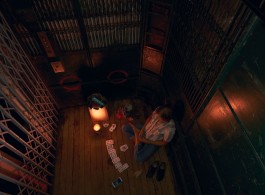David Zwirner, New York
David Zwirner is pleased to present an exhibition of new photographs by Stan Douglas—the artist’s fourteenth solo exhibition with the gallery—at 525 West 19th Street in New York. On view will be works from two recent series, DCT (2016–ongoing) and Blackout (2017), that together illustrate the artist’s overarching interest in the nature of photographic representation and its relationship to reality.
Since the late 1980s, Douglas has created films and photographs—and more recently theater productions and other multidisciplinary projects—that investigate the parameters of their medium. His wide-ranging inquiry into technology’s role in image making, and how those mediations infiltrate and shape collective memory, has resulted in works that are at once specific in their historical and cultural references and broadly accessible. Since the beginning of his career, photography has been a central focus of Douglas’s practice, utilized at first as a means of preparing for his films and eventually as a powerful pictorial tool in its own right. The artist is influenced in particular by media theorist Vilém Flusser’s notion of the photographic image as an encoded language that is determined by a specific set of technological, social, cultural, and political circumstances.
The abstract compositions that comprise Douglas’s DCT series are in essence synthetic pictures that look at photography as an optical image in the broadest sense. To create these works, Douglas manipulates a sequence of data points referred to as a “DCT” (discrete cosine transform), which specify how JPEG images are compressed. He manually inputs the frequencies, amplitudes, and color values that make up each work—determining each composition solely by entering this series of numbers into a custom-designed program. The resulting images emerge as photographs of a hermetic language, completely divorced from any referent in the real world. Printed on large, square panels that have been primed with gesso, they stretch the notion of the photographic and blur the boundaries between photography and painting. The first works in the series were debuted in Douglas’s 2016 Hasselblad Award solo exhibition at the Hasselblad Center in Gothenburg, Sweden, and the compositions that will be on view in this exhibition represent a more expansive and nuanced investigation into pictorial abstraction as well as the complex relationship between technology and image making.
Conversely, in his Blackout photographs, Douglas has scripted and staged scenes from a hypothetical present-day emergency scenario of the total loss of power in New York City. A rare series set in contemporary times, and only Douglas’s second work to be shot in New York, these imagined vignettes are meticulously planned, seamlessly interweaving fact and fiction in their evocation of past events that affected the city, such as the 1977 blackout or, more recently, Hurricane Sandy. Beginning with his 2008 Crowds and Riots series, in which he reconstructed the 1971 Vancouver Gastown Riots, Douglas has used the photographic medium as a tool for understanding the interpersonal dynamics that arise in such moments of societal fracture. In 2017, the artist turned his focus to the pervasive global unrest of 2011—a year that saw Occupy Wall Street, the Arab Spring, and riots in cities including London and Douglas’s native Vancouver, amongst other mass protests. In Blackout, as in these related series, Douglas juxtaposes images that are filmic in their sweeping overview of what a collectively felt catastrophe might look like, with others that offer intimate glimpses into individual experiences. Through this visual tension, he effectively redirects focus to a basic human level—foregrounding how new rules and relationships are forged in such liminal moments and evoking a range of emotions through subtle visual cues.
Stan Douglas was born in 1960 in Vancouver, where he continues to live and work. He studied at Emily Carr College of Art in Vancouver in the early 1980s. Douglas was one of the first artists to be represented by David Zwirner, where he had his first American solo exhibition in 1993.
Douglas’s work has been the subject of solo exhibitions at prominent institutions worldwide since the 1980s. Most recently, Stan Douglas: Interregnum opened at WIELS Centre d’Art Contemporain, Brussels, in 2015 and traveled to Salzburger Kunstverein, Salzburg, the following year. In 2013, a major survey of the artist’s work, Stan Douglas: Photographs 2008–2013, was presented at Carré d’Art – Musée d’Art Contemporain in Nîmes, France. It traveled as Stan Douglas: Mise en scène through 2015 to Haus der Kunst, Munich, followed by Nikolaj Kunsthal, Copenhagen, and Irish Museum of Modern Art, Dublin. Other major solo presentations of the artist’s work include those held at Museu Coleção Berardo, Lisbon (2015); The Fruitmarket Gallery, Edinburgh (2014); Minneapolis Institute of Arts (2012); Staatsgalerie Stuttgart and Württembergischer Kunstverein, Stuttgart (2007); The Studio Museum in Harlem, New York (2005); Serpentine Gallery, London (2002); Centre Georges Pompidou, Paris (1994); and Art Gallery of Ontario, Toronto (1987). The artist’s work was featured in the Venice Biennale in 1990, 2001, and 2005, and in documenta in 1992, 1997, and 2002.
Douglas’s first multimedia theater production, Helen Lawrence, debuted at The Arts Club Theatre Company, Vancouver, in March 2014 and has subsequently been hosted by the Münchner Kammerspiele, Munich; Edinburgh International Festival; Canadian Stage, Toronto; Brooklyn Academy of Music, New York; deSingel, Antwerp; and Center for the Art of Performance, University of California, Los Angeles (co-organized by Los Angeles County Museum of Art).
Douglas has been the recipient of notable awards, including the Hasselblad Foundation International Award in Photography (2016); the third annual Scotiabank Photography Award (2013); and the Infinity Award from the International Center of Photography, New York (2012).
Work by the artist is held in major museum collections, including the Art Gallery of Ontario, Toronto; Centre Georges Pompidou, Paris; The Israel Museum, Jerusalem; Los Angeles County Museum of Art; Museum of Contemporary Art Chicago; The Museum of Modern Art, New York; National Gallery of Canada, Ottawa; Pérez Art Museum Miami; San Francisco Museum of Modern Art; Solomon R. Guggenheim Museum, New York; Tate Gallery, London; Vancouver Art Gallery; and the Walker Art Center, Minneapolis.



